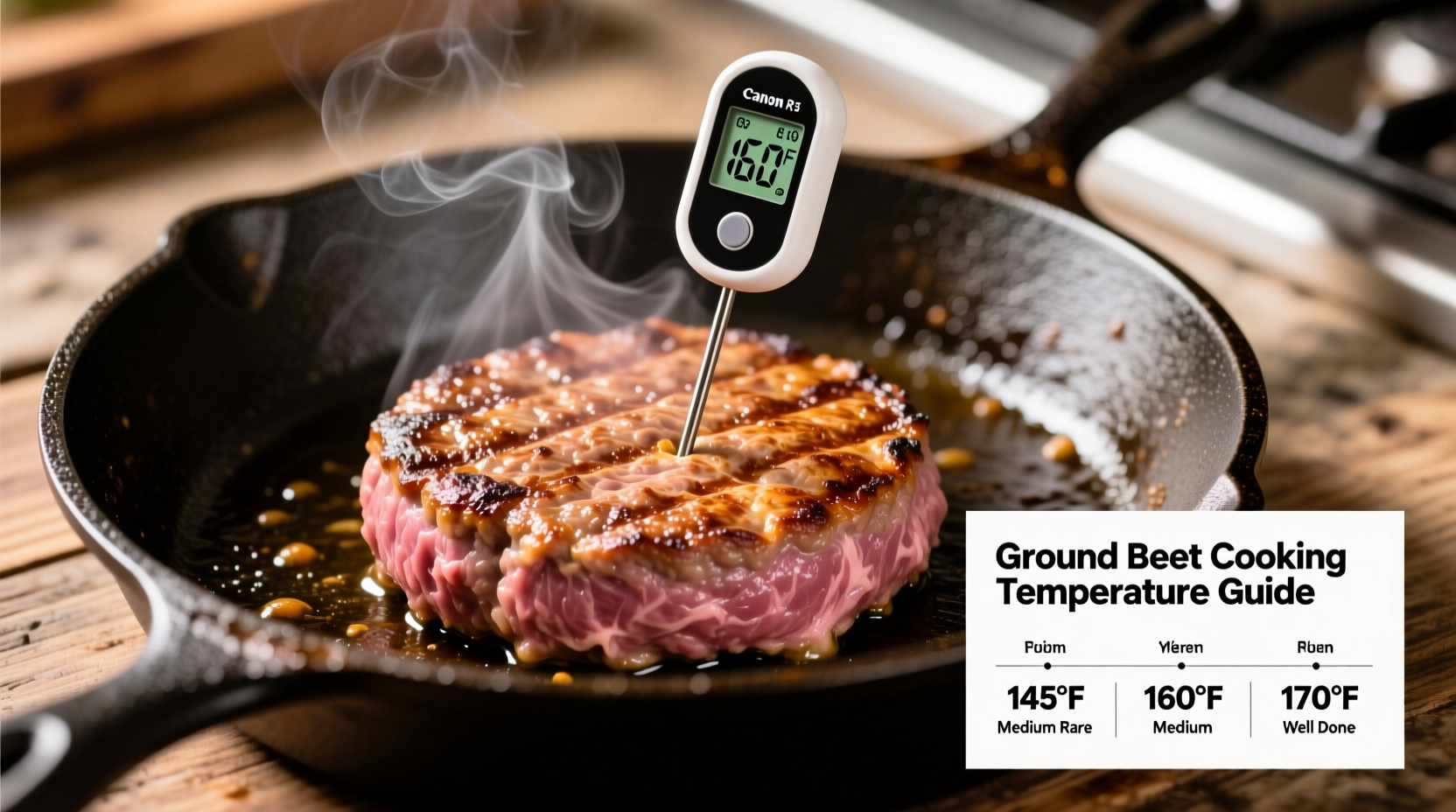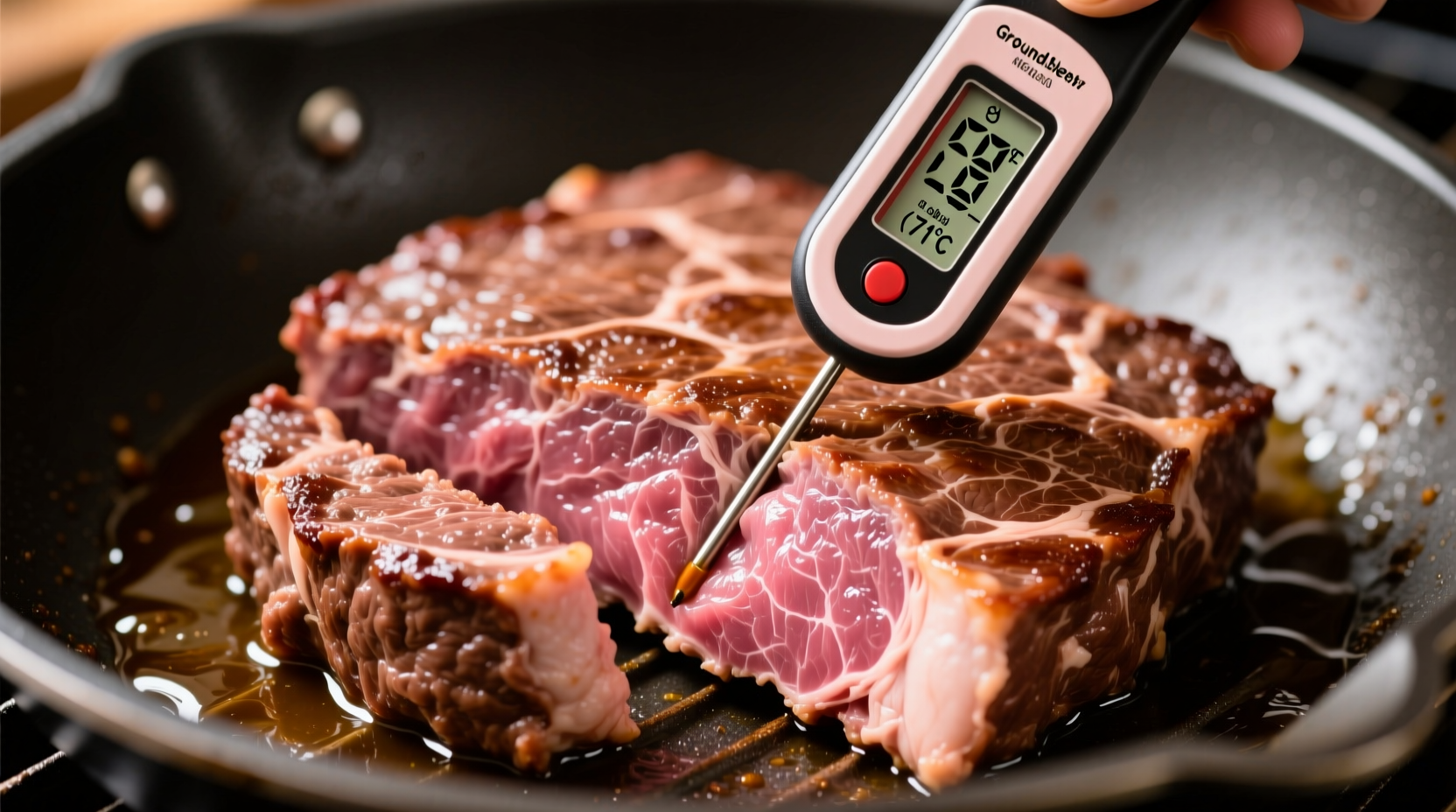Discover exactly why this precise temperature matters for your health, how to measure it correctly every time, and common mistakes that could put you at risk. Whether you're making burgers, meatloaf, or tacos, this guide gives you the science-backed facts to cook ground beef safely without sacrificing flavor.
Why 160°F Is Non-Negotiable for Ground Beef Safety
Unlike whole cuts of meat where surface bacteria are the primary concern, ground beef presents unique food safety challenges. The grinding process distributes potentially harmful bacteria like E. coli O157:H7 and Salmonella throughout the entire product. This is why ground beef requires a higher internal temperature than steaks or roasts.
The USDA Food Safety and Inspection Service confirms that 160°F (71°C) is the critical threshold where these dangerous pathogens are eliminated instantly. At this temperature, the proteins in harmful bacteria denature, rendering them incapable of causing illness. Lower temperatures simply don't provide the same level of protection.
| Meat Type | Recommended Internal Temperature | Key Pathogens Eliminated |
|---|---|---|
| Ground Beef | 160°F (71°C) | E. coli, Salmonella |
| Steaks/Roasts | 145°F (63°C) + 3 min rest | Surface bacteria only |
| Poultry | 165°F (74°C) | Salmonella, Campylobacter |
| Pork | 145°F (63°C) + 3 min rest | Trichinella |
The Evolution of Ground Beef Safety Standards
Food safety guidelines for ground beef have evolved significantly as our understanding of foodborne pathogens has improved. In the 1980s, many cookbooks recommended cooking ground beef to 150°F or even lower. However, after several high-profile E. coli outbreaks linked to undercooked ground beef in the 1990s, particularly the 1993 Jack in the Box incident that affected over 700 people, safety standards were reevaluated.
The USDA officially established the 160°F standard in 1995 based on research from the Food Safety and Inspection Service. This temperature was selected because it provides a significant safety margin while still producing palatable results. According to the USDA Food Safety and Inspection Service, this recommendation remains unchanged because scientific evidence consistently supports its effectiveness.
Proper Temperature Measurement Technique
Knowing the correct temperature is only half the battle—you must measure it accurately. Many home cooks make critical errors when checking ground beef temperature:
- Using the wrong thermometer: Digital instant-read thermometers provide the most accurate results for thin patties
- Measuring in the wrong spot: Insert the probe into the thickest part, avoiding contact with the cooking surface
- Checking too early: Wait 10-15 seconds for the reading to stabilize
- Testing only one patty: Check multiple patties as heat distribution varies
For best results, calibrate your thermometer regularly using the ice water (32°F/0°C) or boiling water (212°F/100°C at sea level) methods. The FDA Food Code specifies that thermometers used for food safety should be accurate within ±2°F (±1°C).
Visual Doneness Indicators: Why Color Alone Isn't Enough

Many home cooks rely on visual cues like color change to determine doneness, but this method is dangerously unreliable. Ground beef can appear brown before reaching a safe temperature, or remain pink even after proper cooking due to factors like:
- pH levels in the meat
- Added ingredients like marinades or seasonings
- Certain cooking methods like smoking
- Natural myoglobin variations
The USDA explicitly states: "Color is not a reliable indicator that meat or poultry is cooked to a temperature high enough to kill harmful bacteria." Only a properly used food thermometer provides the certainty you need for safe consumption.
Special Considerations for Different Cooking Scenarios
Certain cooking situations require additional attention to ensure ground beef reaches the safe 160°F threshold:
High Altitude Cooking
At elevations above 3,000 feet, water boils at lower temperatures, which affects cooking times. You'll need to increase cooking time by approximately 25% to ensure ground beef reaches 160°F internally. Always verify with a thermometer rather than relying on time estimates.
Cheese-Stuffed or Stuffed Patties
When adding fillings like cheese or bacon to burger centers, create a thicker barrier of meat around the filling. The filling can insulate the center, requiring longer cooking to reach 160°F throughout. Insert your thermometer through the side to check the temperature at the meat-filling interface.
Smaller Portions Like Meatballs
For meatballs, meatloaf, or other smaller ground beef preparations, the surface-to-volume ratio means they can cook through more quickly. However, the same 160°F standard applies. Check multiple pieces as size variations affect cooking times.
Common Misconceptions About Ground Beef Cooking
Several persistent myths could put your health at risk:
- "If it's brown inside, it's safe" - As mentioned, color isn't reliable; use a thermometer
- "Restaurant burgers can be pink, so I can too" - Restaurants follow strict sourcing and handling protocols most home kitchens don't have
- "Resting time will raise the temperature enough" - Unlike roasts, ground beef doesn't experience significant temperature rise during resting
- "Organic or grass-fed beef is safer" - All ground beef carries similar pathogen risks regardless of production method
Remember that food safety guidelines exist for everyone—not just vulnerable populations. While children, elderly individuals, and immunocompromised people face higher risks from foodborne illness, healthy adults can still experience severe consequences from pathogens like E. coli O157:H7.
Practical Tips for Perfectly Cooked, Safe Ground Beef
Follow these professional techniques to achieve safe temperatures without overcooking:
- Preheat your cooking surface properly to create an immediate sear
- Avoid pressing down on patties, which squeezes out juices and leads to dryness
- For thicker patties, use a two-zone cooking method (sear then finish over indirect heat)
- Remove patties from heat at 155°F—they'll continue rising to 160°F during brief rest
- Always clean your thermometer probe between measurements
By understanding the science behind the 160°F requirement and implementing proper temperature verification techniques, you can enjoy delicious ground beef dishes with complete confidence in their safety. This knowledge transforms cooking from guesswork to a precise, reliable process that protects you and your loved ones.
Can ground beef be safe at 150°F if it's high quality?
No, all ground beef must reach 160°F regardless of quality or source. The grinding process distributes bacteria throughout the meat, requiring this specific temperature to ensure pathogens like E. coli are destroyed. Higher quality beef doesn't eliminate this food safety requirement.
Why does ground beef need a higher temperature than steak?
Whole cuts like steaks only require surface bacteria to be killed (145°F), as pathogens don't penetrate the interior. Grinding distributes potential contaminants throughout the product, necessitating a higher internal temperature (160°F) to eliminate bacteria in every part of the meat.
How long after reaching 160°F should I let ground beef rest?
Ground beef patties need minimal resting time—about 2-3 minutes is sufficient. Unlike larger roasts, ground beef doesn't experience significant temperature carryover during resting. The primary purpose of resting is to allow juices to redistribute for better texture.
What happens if I eat ground beef cooked to 155°F?
Consuming ground beef at 155°F carries increased risk of foodborne illness. While some bacteria begin dying at lower temperatures, 160°F is the threshold where pathogens like E. coli are eliminated instantly. At 155°F, it takes approximately 3 minutes to achieve the same level of bacterial reduction, which many home cooks don't account for.
Does freezing ground beef kill bacteria so I can cook it to lower temperatures?
No, freezing does not kill harmful bacteria—it only puts them in a dormant state. When ground beef thaws, any present pathogens become active again. You must still cook frozen ground beef to 160°F to ensure safety, though it will require longer cooking time to reach this temperature throughout.











 浙公网安备
33010002000092号
浙公网安备
33010002000092号 浙B2-20120091-4
浙B2-20120091-4